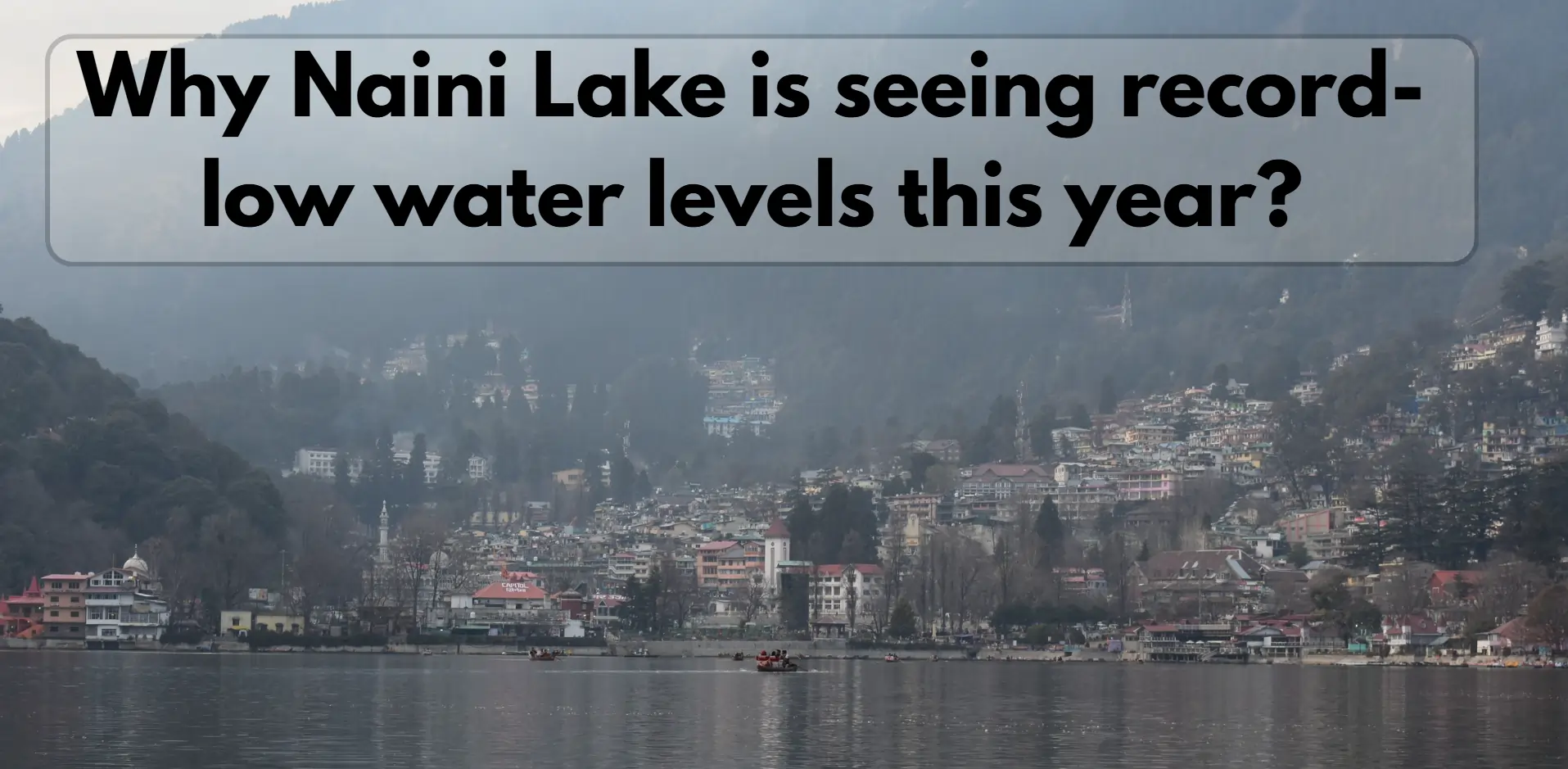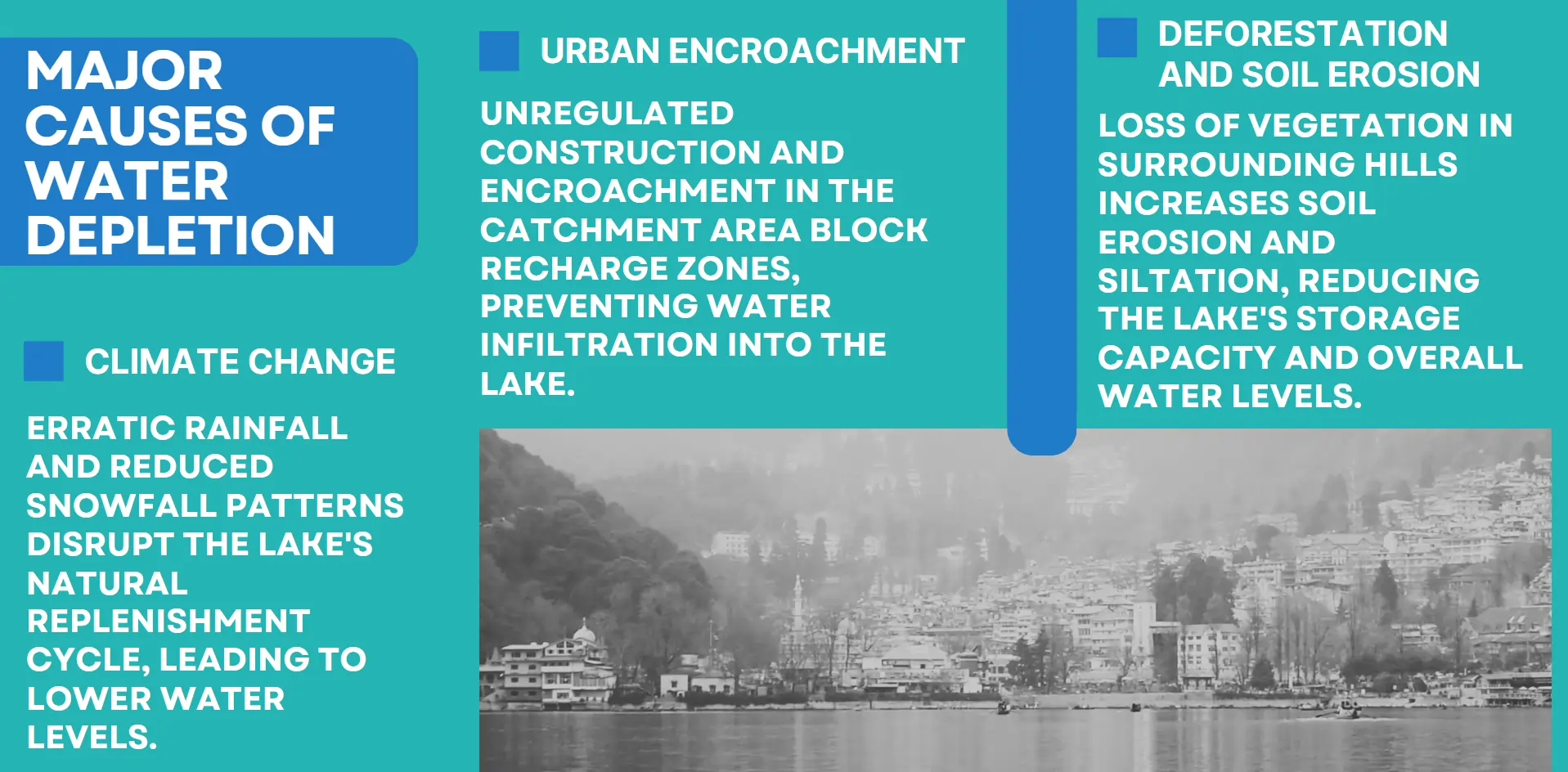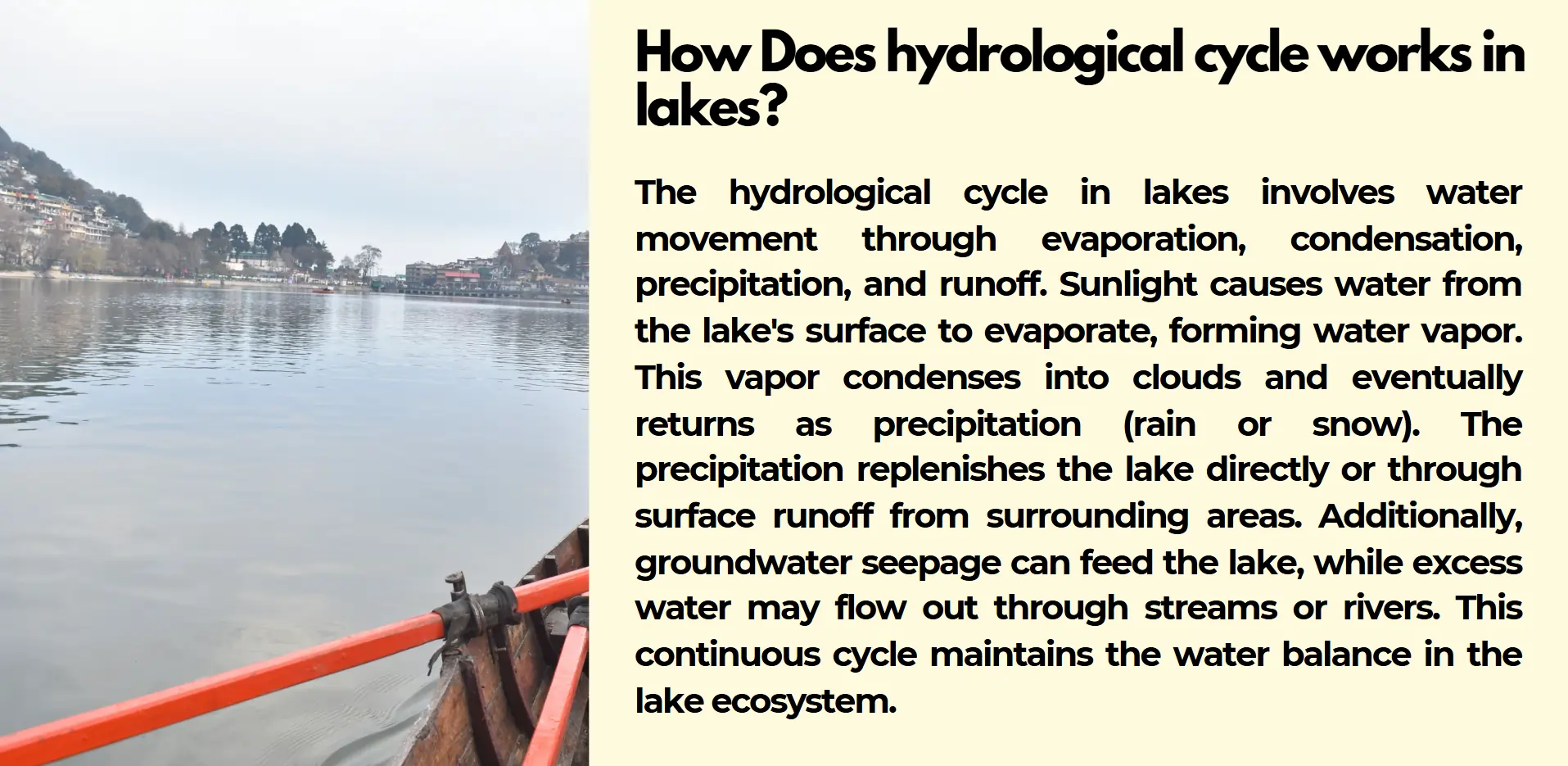Naini Lake serves as an essential resource in Nainital by supporting both the economic system and environmental ecosystem although it endures harmful pressures from human-initiated deforestation and activities.

Naini Lake faces record-low water levels in 2024. Naini Lake represents the shimmering gem of Nainital that sustains the population of residents alongside the ecosystem and tourism industry of the area. Naini Lake faces depletion due to climate change, population growth, and encroaching construction, impacting tourism and drinking water supply. The water levels of this year exhibited a worrying decrease which established new all-time low records throughout the entire community. The combination of fluctuating rainfall patterns together with deforestation processes and uncontrolled human involvement are the main elements believed to fuel this dangerous situation. The dwindling state of the lake demonstrates multiple pressing issues linked to the environment and society while impacting the local economy. Researchers investigate main factors that cause the lake's poor condition while studying the broad effects and current protection plans for this essential natural resource.
Explained Why Naini Lake is seeing record-low water levels this year
The picturesque Naini Lake exists as a crucial historical element that defines the central identity of Nainital while also acting as its principal scenic spot. Legend and geologic development have together shaped its existence. Religious significance accompanies Naini Lake in Hindu mythology since the lake became sacred when a piece of Sati fell there and the name Nain refers to an eye. Geologic evidence suggests that the tectonic depression filled with water steadily over time finally became the present-day serene water body.
Naini Lake transformed into a key factor that enabled British to found Nainital as their summer retreat during the colonial period. British officials located Naini Lake and its nearby region in the middle of the 19th century after they perceived its potential for escaping the scorching plains. Nainital grew around this picturesque lake which brought settlers alongside numerous tourists to the region. The British town development revolved around Naini Lake through their construction of roads as well as schools and churches that made use of the water body for resource purposes and recreational activities.
Since its discovery Naini Lake established itself as the ecological foundation of the area by providing water not only for population expansion but also powering the tourism economy. People from worldwide destinations visit Nainital specifically to admire its clean lake water which represents the area's natural splendour. The stability enjoyed by the lake during history has suffered from growing human disturbances together with environmental change effects. The former strong natural system endures major problems because of urban development together with forest clearing and environmental changes.
To fully value how Naini Lake has developed while comprehending its current challenges we must examine its past historical development. As a symbol of natural and human development synergy the lake demonstrates the need for a careful equilibrium that will protect its existence.
Current Situation- Water Level Concerns in Naini Lake
The water level of Naini Lake reached its lowest recorded mark this year as the current crisis threatens its existence. The lake which used to represent richness along with natural elegance now displays environmental deterioration caused by humans. New measurements reveal a drastic drop in water level compared to past years which caused widespread concern among every stakeholder group working around Naini Lake.
The water reduction has caused such major shoreline erosion that submerged lake areas now show in the exposed lakebed. The water shortage concerns local residents because Nainital along with adjoining areas depends on Bhumiadhaar Lake as their foremost drinking water source. Presently the tourism industry which depends heavily on the lake attraction is facing difficulties because of the lake's poor condition which harms recreational activities and scenic beauty.
The latest lake condition stems from unstable rain patterns together with diminished snowfall and persistent human activities that disrupt natural water replenishment areas. The situation worsens because pollution combines with excessive water extraction from the source. The urgent situation of the lake requires sustainable solutions and long-term sustainable practices because authorities have been unable to stop its declining health through conservation and awareness programs.
Causes of Record-Low Water Levels
The present severe water level reduction of Naini Lake occurs because various environmental and human-induced factors have combined to disrupt its natural balance. It is vital to identify the causes of this situation because such knowledge builds the foundation for strong lake management strategies that will preserve Naini Lake in the long term.
Climate Change and Altered Weather Patterns
Climate change has resulted in diminished water levels at the lake through its modifications of weather patterns in the region. Two detrimental effects have occurred in Nainital since the year began: inconsistent rainfall coupled with vital seasons receiving decreased snow accumulations. The water replenishment system of the lake depends on snowmelt and rain amounts yet changing weather patterns have disturbed these natural water sources. The heat increase makes the problem worse because it causes faster evaporation and decreased water retention capacity in the lake.

Urban Encroachment and Land Use Changes
The expanding urban development in Nainital area has caused major degradation to the natural water recharge zones of Naini Lake. Builders conducting regulated and unregulated operations have taken control of the lake's watershed space which blocks the natural water flow from the surface runoff. The implementation of concrete surfaces instead of permeable soil prevents groundwater from reaching the lake which consequently reduces its water retention ability. The uncontrolled urban growth in the region leads to ecological destruction which intensifies pressure on vulnerable ecosystems.
Deforestation and Soil Erosion
The degradation caused by deforestation throughout surrounding hills stands out as a main cause behind decreasing water levels in the lake. The hydrological cycle functions best through forests because their root systems stabilize earth and allow water to penetrate subterranean water reserves. Soil erosion becomes worse when vegetation disappears because the storage and water filtration capability of the water catchment area decreases. Lake accumulation of sediment from washed materials leads to Lake Siltation reducing lake surface area while diminishing its capacity to store water during each time period.
Pollution and Waste Management Issues
The introduction of major pollution by human activities has weakened water quality and water levels in Naini Lake. The delicate ecosystem of the lake becomes disrupted due to settlement sewage that remains untreated along with inadequate waste disposal practices. Water pollutants create dual damage to lake quality because they harm the environment’s water condition and its biological communities. Continued accumulation of contaminants weakens the lake until it reaches a point where it fails to resist environmental stressors like water depletion.

Over-extraction and Overdependence
The residents of Nainital and adjacent areas obtain their drinking water from this vital lake which creates pressure for excessive water extraction. The lake's natural replenishment rate cannot keep up with the modern level of water extraction caused by population increases and tourist demands. The aging water distribution system has made the water conservation situation worse because leaks combined with inefficiencies cause unnecessary waste.
Systemic Challenges
The lake suffers because of system-wide issues involving faulty urban development strategies and weak environmental protection law enforcement together with subpar resource management approaches. Increasing awareness has not led to effective lake health preservation initiatives because they face inadequate implementation and insufficient backing from stakeholders.
Implications
The extreme low water levels at Naini Lake generate multiple consequences which affect the regional environmental ecosystem and the social economic system of the area. The increasing crisis calls for immediate intervention strategies to stop the worsening situation.
Environmental Impact
The decreasing water levels in Naini Lake currently endanger the complete environment of the area. The reduction of lakebed size generates environmental damage because it destroys aquatic species habitats and diminishes the ecological diversity found throughout the lake region. All aquatic species together with amphibians alongside many other dependent organisms survive best when water stays stable. The combined impact of lower water levels causes siltation which results in decreased capacity alongside water quality deterioration of the lake.
When the lake lacks enough water it becomes unable to maintain healthy vegetation growth around its shores. Soil around the catchment area will likely suffer from water stress that leads to less vegetation and stronger risks of erosion. This, in turn, leads to weakened natural barriers against runoff, accelerating degradation.
Socioeconomic Impact
The deteriorating condition of the lake threatens Nainital’s principal economic sector which is tourism. The approximately four thousand annual visitors are attracted to Naini Lake because of its natural charm and calm boating opportunities. Deteriorating site quality together with reduced water levels causes the place to become less attractive for visitors. Commercial activities throughout Nainital face negative consequences from reduced visitor numbers since tourism drives the local economy through ocean-to-lake and land-based businesses. Decreasing tourism profits creates economic burden on the town while endangering local jobs and causing financial problems for those who reside there.
The diminished lake imposes serious threats to the water supply of the surrounding residents. Drinking water consumption in Nainital depends heavily on Naini Lake but the lowering water quantity diminishes its capacity to serve the expanding permanent and temporary residents of the area. The scarcity of water supply mostly affecting summer months has the potential to create public health emergencies and civil disturbances.
Implications for Public Health
Lowering water levels leads to increased pollution density which degrades the quality of water present in the lake. As nearby settlements dispose their sewage and waste into the diminishing water reserves it creates major health threats for the public. There exists an increased chance for waterborne diseases because of water contamination which affects public health conditions in the local population. Residents face the challenge of obtaining their water supply from unsafe and unsustainable sources because the scarcity of clean water becomes imminent.
Long-Term Risks
The current Naini Lake environmental crisis functions as an important sign regarding how environmental destruction affects societies in general. Without intervention the emergency situation will likely provoke damage beyond repair so Nainital could lose its famous water reservoir and all of its accompanying benefits. The disappearance of Naini Lake will destroy the cultural foundation that makes Nainital a famous hill station and create permanent economic troubles for the area.
Efforts to Address the Crisis
Mounting public awareness and civil engagement stand as proof that major initiatives fight against declining water levels in Naini Lake. A combination of government departments, specialist professionals and local community membership exists to remedy dangerous water level reductions while bringing back life to the lake system.
Government Measures
Assembly-approved policies establish control over urban development throughout the lake watershed by applying protection measures to recharge areas. The proposed infrastructure improvement plans include resolving water distribution problems in networks while minimizing system loss. Through environmental regulations the government operates to stop illegal tree-cutting combined with encroachment behaviour.
Scientific and Environmental Efforts
Experts determine sustainable techniques need to be chosen first as a remedy for the base depletion of the lake. Natural recharge channel restoration maintains its position as one of the most crucial steps for increasing water replenishment in the lake. Afforestation projects help reduce soil instability and they enhance the ground infiltration rate of water. Urban planners use environmental approaches to implement sustainable development to reach equal outcomes for development and conservation.
Community Engagement
People residing in the area together with community organizations play an essential role in responding to the crisis. Active awareness programs teach population masses how to save water resources while providing training for Naini Lake environmental protection. The local population now collaborates to conduct waste removal activities in Lake and catchment areas to combat pollution and beautify the natural environment.
Conclusion- Naini Lake faces record-low water levels in 2024
The present low water condition of Naini Lake proves beyond doubt that human conduct continuously exposes natural ecosystems to danger. The life-giving source at Nainital faces two main threats from environmental change and from both unsustainable management and urban growth practices. A solution to this crisis needs society-wide collaboration between people who will defend recharge zones alongside the enforcement of protective standards and public participation programs. Protected environmental health of Naini Lake alongside its cultural and economic significance will ensure its status as a vital asset for future generations.